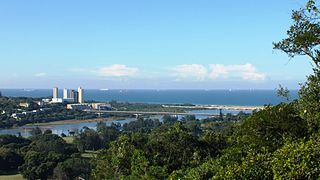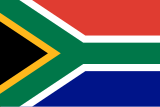
South Africa occupies the southern tip of Africa, its coastline stretching more than 2,850 kilometres from the desert border with Namibia on the Atlantic (western) coast southwards around the tip of Africa and then northeast to the border with Mozambique on the Indian (eastern) coast. The low-lying coastal zone is narrow for much of that distance, soon giving way to a mountainous escarpment that separates the coast from the high inland plateau. In some places, notably the province of KwaZulu-Natal in the east, a greater distance separates the coast from the escarpment. Although much of the country is classified as semi-arid, it has considerable variation in climate as well as topography. The total land area is 1,220,813 km2 (471,359 sq mi). It has the 23rd largest Exclusive Economic Zone of 1,535,538 km2 (592,875 sq mi).

Griqualand East, officially known as New Griqualand, was one of four short-lived Griqua states in Southern Africa from the early 1860s until the late 1870s and was located between the Umzimkulu and Kinira Rivers, south of the Sotho Kingdom.

The Umgeni River or Mgeni River is a river in KwaZulu-Natal, South Africa. It rises in the "Dargle" in the KZN Midlands, and its mouth is at Durban, some distance north of Durban's natural harbour. It is generally agreed its name means "the river of entrance" in Zulu, though other meanings have been suggested.

The Durban Light Infantry is a Motorised Infantry regiment of the South African Army. It lost its status as a Mechanised infantry regiment in 2010 in line with the rationalisation of resources. As a reserve unit, it has a status roughly equivalent to that of a British Army Reserve or United States Army National Guard unit.
A polo handicap is a system created by Henry Lloyd Herbert, the first president of the United States Polo Association, at the founding of the USPA in 1890 so teams could be more evenly matched when using players with varying abilities.
Claire Janet Tomlinson was an English polo player and pony breeder. She was the highest-rated female polo player and coached the English national team she once captained.
The Cape Colonial Forces (CCF) were the official defence organisation of the Cape Colony in South Africa. Established in 1855, they were taken over by the Union of South Africa in 1910, and disbanded when the Union Defence Forces were formed in 1912.

The Federation of International Polo (FIP) is the international federation representing the sport of polo, officially recognized by the International Olympic Committee. The FIP was founded in 1982 by representatives of eleven national polo associations, and it represents the national polo associations of more than 80 countries. Its principal aim is to enhance the international image and status of polo.
This article describes the history of South African cricket from the 2000–01 season. Noted South African players in the 21st century have included Jacques Kallis, Shaun Pollock, Makhaya Ntini, Mark Boucher, Graeme Smith and Herschelle Gibbs.
There have been many political assassinations in post-apartheid South Africa. In 2013 it was reported that there had been more than 450 political assassinations in the province of KwaZulu-Natal since the end of apartheid in 1994. In July 2013 the Daily Maverick reported that there had been "59 political murders in the last five years". In August 2016 it was reported that there had been at least twenty political assassinations in the run up to the local government elections on the 3rd of August that year, most of them in KwaZulu-Natal.

The Oxford University Polo Club is the Discretionary Full Blue sports club for competitive polo at Oxford University. Founded in 1874, it is one of the four oldest continuing polo clubs worldwide. Its annual Varsity Match against Cambridge University Polo Club, established in 1878, is the second oldest continuing polo fixture in the Western world. It is played at Guards Polo Club, England, usually at the beginning of June.
The Australian Polo Federation is the governing body for the sport of Polo in Australia.
This page details the South African Army order of battle in 1940, before and after the formation of expeditionary forces.

Griqualand East Commando was a light infantry regiment of the South African Army. It formed part of the South African Army Infantry Formation as well as the South African Territorial Reserve.
Mary Agnes Stainbank (1899–1996) was a South African sculptor.
Marianne or Edda Fannin was an Irish botanical artist, known for her work painting the flora of South Africa. She was regarded as one of the principle South African botanical artists of her time.
The Down East Polo Club is the only polo club in Maine, U.S. It is located in South Harpswell, It was established in 1978, and affiliated with the United States Polo Association in 1984.
The following is a timeline of the history of Pietermaritzburg. It is part of the Msunduzi Local Municipality in the Umgungundlovu District Municipality, KwaZulu-Natal province, South Africa.
The Argentine Polo Association is the guiding entity of the game of Polo in the Argentina. It is a non-profit association constituted on September 14, 1922 in Buenos Aires.








